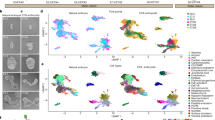Summary
Initially, each tissue-progenitor blastomere of embryos of the ascidian Halocynthia was identified and isolated manually at the 110-cell (late-blastula) stage, the time at which most of the blastomeres have assumed a particular fate, such that each gives rise to a single type of tissue. The isolates were allowed to develop as partial embryos, then tissue differentiation was examined by monitoring the expression of specific molecular markers for differentiation of epidermis, endoderm, muscle and notochord. Essentially, all of the precursor blastomeres of these four kinds of tissue expressed the appropriate features of tissue differentiation in isolation, indicating that determination is already complete in most of the blastomeres by the 110-cell stage. Next, in order to evaluate the absolute capacity of cells for autonomous development, embryos were maintained continuously in a dissociated state from the first cleavage to the 110-cell stage, then the cells were allowed to develop into partial embryos. Tissue differentiation in the partial embryos was examined. The results showed the striking autonomy of the processes of segregation of developmental potential, as well as the autonomy of the processes of expression of differentiated phenotypes, namely those of epidermis and endoderm. Autonomous muscle differentiation was also observed; however, excess formation of “muscle” partial embryos occurred. The hypothesis that fate determination is mediated by localized maternal information in the egg cytoplasm is supported by the evidence of development of these tissues. By contrast, no evidence of notochord differentiation was observed in the partial embryos.
Similar content being viewed by others
References
Conklin EG (1905) The organization and cell-lineage of the ascidian egg. J Acad Nat Sci (Philadelphia) 13:1–119
Crowther RJ, Whittaker JR (1986) Developmental autonomy of presumptive notochord cells in partial embryos of an ascidian. Int J Invert Reprod Dev 9:253–261
Davidson EH (1986) Gene activity in early development, 3rd edn. Academic Press, New York
Durante M (1956) Cholinesterase in the development of Ciona intestinalis (Ascidia). Experientia 12:307
Karnovsky MJ, Roots L (1964) A “direct-coloring” thiocholine method for cholinesterase. J Histochem Cytochem 12:219–221
Makabe KW, Satoh N (1989) Temporal expression of myosin heavy chain gene during ascidian embryogenesis. Dev Growth Differ 31:71–77
Minganti A (1954) Fosfatasi alcaline nello sviluppo delle Ascidie. Pubbl Staz Zool Napoli 25:9
Nishida H (1986) Cell division pattern during gastrulation of the ascidian. Halocynthia roretzi. Dev Growth Differ 28:191–201
Nishida H (1987) Cell lineage analysis in ascidian embryos by intracellular injection of a tracer enzyme: III. Up to the tissue restricted stage. Dev Biol 121:526–541
Nishida H (1990) Determinative mechanisms in secondary muscle lineages of ascidian embryos: development of muscle-specific features in isolated muscle progenitor cells. Development 108:559–568
Nishida H (1991) Induction of brain and sensory pigment cells in the ascidian embryo analyzed by experiments with isolated blastomeres. Development 112:389–395
Nishida H, Satoh N (1983) Cell lineage analysis in ascidian embryos by intracellular injection of a tracer enzyme: 1. Up to the eight-cell stage. Dev Biol 99:382–394
Nishida H, Satoh N (1989) Determination and regulation in the pigment cell lineage of the ascidian embryo. Dev Biol 132:355–367
Nishikata T, Satoh N (1990) Specification of notochord cells in the ascidian embryo analyzed with a specific monoclonal antibody. Cell Differ Dev 30:43–53
Nishikata T, Mita-Miyazawa I, Deno T, Satoh N (1987a) Muscle cell differentiation in ascidian embryos analyzed with a tissuespecific monoclonal antibody. Development 99:163–171
Nishikata T, Mita-Miyazawa I, Deno T, Takamura K, Satoh N (1987b) Expression of epidermis-specific antigens during embryogenesis of the ascidian Halocynthia roretzi. Dev Biol 121:408–416
Okado H, Takahashi K (1988) A simple ‘neural induction’ model with two interacting cleavage-arrested ascidian blastomeres. Proc Natl Acad Sci USA 85:6197–6201
Rose SM (1939) Embryonic induction in the ascidian larva. Biol Bull 77:216–232
Satoh N, Deno T, Nishida N, Nishikata T, Makabe KW (1990) Cellular and molecular mechanisms of muscle cell differentiation in ascidian embryos. Int J Cytol 122:221–258
Venuti JM, Jeffery WR (1989) Cell lineage and determination of cell fate in ascidian embryos. Int J Dev Biol 33:197–212
Whittaker JR (1987) Cell lineages and determinants of cell fate in development. Am Zool 27:607–622
Whittaker JR, Meedel TH (1989) Two histospecifc enzyme expressions in the same cleavage-arrested one-celled ascidian embryos. J Exp Zool 250:168–175
Wilson EB (1925) The cell in development and heredity, 3rd edn. Macmillan, New York
Author information
Authors and Affiliations
Rights and permissions
About this article
Cite this article
Nishida, H. Developmental potential for tissue differentiation of fully dissociated cells of the ascidian embryo. Roux's Arch Dev Biol 201, 81–87 (1992). https://doi.org/10.1007/BF00420418
Received:
Accepted:
Issue Date:
DOI: https://doi.org/10.1007/BF00420418




